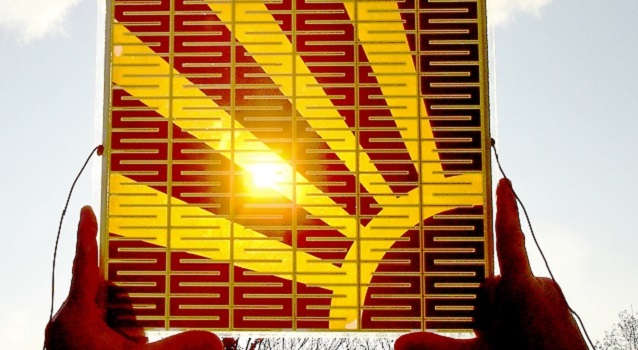Sustainable product innovation using dye-sensitized solar cells
Climate protection and supply security will play a vital role in the future of energy supply. Ubiquitously available photovoltaic energy is a particularly attractive and sustainable source of electrical energy for buildings, remote areas or mobile applications. The dye-sensitized solar cell, an innovative new solar cell technology, is giving rise to new applications.
Research on dye-sensitized solar cells has carried out for over 25 years worldwide. In contrast to conventional solar cells, the underlying principle is the conversion of light into electrical energy by means of an organic dye.
Dye-sensitized solar cells are produced using simple screen-printing and are a promising technological development with regard to production, application and sustainability. Because of its straightforward production, there is a high degree of potential for reducing resource consumption and lowering costs as well as a high degree of suitability for international dissemination. At the same time, opportunities for using photovoltaic solutions, their economic feasibility and energy amortization period for solar cells can all be improved.
The range of colors and semi-transparent surface options available with dye-sensitized solar cells creates new opportunities for design in building-integrated photovoltaics while also combining the traditional facade functions (weather and noise protection) with energy production. The same applies for structures such as bridges, stadiums and outdoor stairways as well as mobile applications such as calculators. The dye-sensitized solar cell stands out for its low cost, environmentally friendly materials, highly variable design and ease of replacement.
The aim of the research project – supported by the German Federal Ministry for Education and Research (BMBF) – was to develop the dye-sensitized solar cell to the application stage and identify appropriate fields of application. This encompassed the following tasks:
- Creation of a road map for the technology and product
- Identification and development of fields of application for dye-sensitized solar cells (such as building facades) while integrating users in this process from an early stage
- Identification of the factors of success for product innovation on the photovoltaic market
- Development of concepts for an environmentally sound product (such as design and production which facilitates recycling)
- Development of printing pastes for the solar cells
- Development and optimization of electrolytes
- Development of a resource-efficient production method that uses environmentally friendly chemicals while improving the energy amortization period
- Establishment of a capable innovation network among various companies along an emerging value chain


